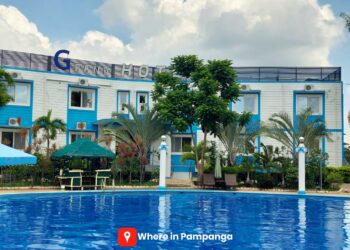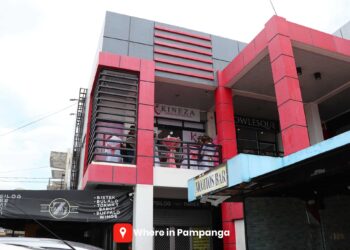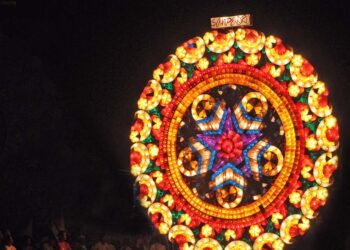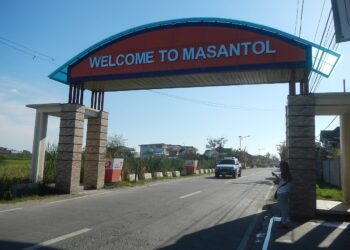The Municipality of Bacolor is a third-class municipality situated in the province of Pampanga.
Bacolor is located in the middle part of Pampanga, bounded on the North by Angeles City and Porac, on the West by Sta. Rita and Guagua, in the East by the City of San Fernando, and in the South by Minalin and Sto. Tomas.
The former name “Baculud” was replaced and renamed “Bacolor” when the Spanish settlers inhabited the area in 1754, and it became the capital of Pampanga.
History
A certain man named Don Kalamaris, rumored to be the founder of Bacolor is a rich property owner. According to some Historical records, the place of Bacolor has been existing as a planned settlement back in 1571.
The Original name of Bacolor was “Baculud,” which means “ground level” because when the Spanish immigrants first found the place its site was formerly on the coastline of Luzon not until, the eruption of the Pinatubo in 1991 where it was located above the ocean floor.
The Malayans from the Atjeth Sumatra group spearheaded by Panday Pira were rumored to be the first immigrants that settled in Bacolor. Allegedly, Monmon, the first cousin and sister-in-law of Malangsic, and a son of Prince Balagtas is supposed to be the founder of Bacolor.
However, some historians documented the official establishment of Bacolor took place in the year 1574 due to Don Guillermo Manabat, also a rich landowner, whose lavish house and resting place is now the present-day site of the San Guillermo Church, hence the church was named after him.
When the Spanish Colonizers came to Bacolor, the name “Baculud” was renamed “Bacolor.” According to some official documents, the town of Bacolor served as the first provincial capital of Pampanga from 1698 to 1904, almost two centuries before the declaration of the City of San Fernando as the newest provincial capital of Pampanga in July 1904.
The Casa Real served as the provincial building that was built in 1757 and is now the location of the present-day Bacolor Elementary School.
When the country’s capital Manila fell to the hand of the British invaders, during the British Occupation of the Philippines, the town of Bacolor then became the capital of the exiled government of Governor-General Simón de Anda y Salazar from October 6, 1762, to May 30, 1764
The provincial offices were momentarily relocated to Factoria, which is now San Isidro, Nueva Ecija. Bacolor continued to be the former capital town of Pampanga not until 1904, the provincial seat of government was moved to the neighboring City of San Fernando.
On November 9, 1765, under the ruling of the King of Spain, Bacolor became” Villa de Bacolor,” one of the only three villas in the Philippines, and was bestowed a Special Coat of Arms.
Simon de Anda prearranged an army of natives with which he finally reclaimed Manila from the British intruders. (There is an incorrect detail in the narrative. The British departed due to the terms of the Treaty of Paris in 1763 and they left by boarding from Manila and Cavite in the 1st week of April 1764, and sailing out of Manila Bay for Batavia, India, and England.)
The invasion of the American conquerors broke up the military form of government and instead political and economic reforms were instituted. The inauguration of the city form of government was organized occurred in the “Escuala de Artes y Officios de Bacolor” (Previously named Pampanga School of Arts and Trade), which is now widely known as the first state university in Pampanga, Don Honorio Ventura Technological State University
The first provincial Civil Governor was Don Ceferino Joven and the first Municipal President of Bacolor was Don Estanislao Santos. The Former US President, General Ulysses S. Grant recognized Pampanga recognized as the 1st province in the Philippines to have a systematized civil government.
When World War II started in December 1941, Japanese combatants and bomber planes attacked the municipal town in Bacolor until the entering town of Bacolor was captured in 1942, by the Imperial Japanese armed forces. Many of all Kapampangan guerrillas and Hukbalahap groups joined in a rebellion centered around the town of Bacolor and support was added by the local soldiers and military officers of the Philippine Commonwealth Army military units. Their aggression towards the Japanese invaders persisted until 1945 when the Filipino and American military forces, which includes the Kapampangan resistance movement and Hukbalahap freedom fighters liberated the Municipality of Bacolor after overcoming the Imperial Japanese army forces and ended World War II.
The sitio of Mesalipit was transformed into a barrio in 1956.
On the early morning of October 1, 1995, over 20 feet (6.1 m) of Lahar from the hills of Mount Pinatubo and nearby mountains covered the whole town of Cabalantian, putting to death at least hundreds of individuals. 18 out of the 21 barangays of Bacolor were buried.
Barangay
The Municipality of Bacolor is subdivided into 21 barangays.
| Balas | Cabalantian | Cabambangan (Poblacion) | Cabetican |
| Calibutbut | Concepcion | Dolores | Duat |
| Macabacle | Magliman | Maliwalu | Mesalipit |
| Parulog | Potrero | San Antonio | San Isidro |
| San Vicente | Santa Barbara | Santa Ines | Talba |
| Tinajero |
Festivals
Feast of San Guillermo
A festive celebration occurred every 3rd Sunday of November in honoring San Guillermo or also known as “William of Maleval or William the Hermit.”
Nuestra Senora del Santissimo Rosario (La Naval)
La Naval also known as the “Makatapak Festivals,” is a celebration that occurred every 10th of February. The purpose of the festivity is to commemorate the toughness of Bacolor townsfolks’ spirit, which is steadily recovering after the 1991’s Pinatubo eruption.
“Makatapak” means barefooted as townsfolks walked without foot sandals or shoes as they had to cross the streets with mud during the damaging years of lahar flows deposited by Mt. Pinatubo’s eruption.
Land Mark and Attraction
San Guillermo Parish Church
San Guillermo Parish Church is popularly known as the ‘sunken church’ and was one of the buildings that were severely affected by the lahar flow of the eruption of Mount Pinatubo. The church has since been repaired and is currently active and may be accessed through what were once the second-floor windows, now transformed into doorways. The sunken church and town of Bacolor were used as the primary location for the 2009 ABS-CBN’s television series, May Bukas Pa.
The Sunken Shrine
Covered mostly by the damaging lahar flows of Mount Pinatubo during its eruption in June 1991, the Archdiocesan Shrine of Our Lady of Lourdes of Cabetican also widely popular as the abbreviated name “Maluca” remains at the center of Marian Concordia Pilgrimages, and Healing in Pampanga. Initially built as an annex to the older shrine, it is under the maintenance of Fr. Ronnie Cao, Healing Priest and Rector of the Archdiocesan Shrine.
Don Honorio Ventura State University
It’s one of the oldest trade schools in the Far east. Formerly known as Escuela de Artes y Oficios de Bacolor, a grammar school. It was established by an Augustinian friar, Fr. Juan P. Zita, on November 4, 1861.
Anda Memorial Obelisk
The initial six-meter-high Anda Obelisk was revealed by town officers in 1853 as a memorial of valor of Gov. Gen. Simon de Anda y Salazar who moved the provincial capital of the Philippines to Bacolor from 1762-64, as the British invaded Manila.
Juan Crisostomo Soto Memorial Bust
Juan Crisostomo C. Soto (widely known by his pen name “Crissot,” is a significant and notable poet, playwright, novelist, journalist, and revolutionary who set off the golden age of Kapampangan literature that zarzuelas of Crissot, raised capital to create a bust memorial, done by a sculptor from Quiapo named Euogio Velarde Garcia. The Crissot Memorial Bust was the first to be sighted after the Lahar flows destruction damaged the Bacolor town in 1995.
FELIX GALURA MONUMENT
A memorial was put up opposite of the Bacolor Elementary School on 24 December 1924, by Aguman 33, dedicated to the recollection of a most-loved son of Bacolor–“Caluguran Nang Anac Ning Baculud”—Felix Napao Galura.
References:
* https://en.wikipedia.org/wiki/Bacolor
* https://www.philatlas.com/luzon/r03/pampanga/bacolor.html
* https://www.tripadvisor.com.ph/Attractions-g2167639-Activities-Bacolor_Pampanga_Province_Central_Luzon_Region_Luzon.html
* https://kaplistorian.blogspot.com/2017/06/49-18-pampanga-landmarks-and-monuments.html
* https://en.wikipedia.org/wiki/San_Guillermo_Parish_Church
* https://www.pampanga.gov.ph/index.php/about-pampanga-2/189-capitol/tourism/municipality/321-bacolor.html
*For corrections or commentaries, please email us at whereinpampanga@gmail.com


















